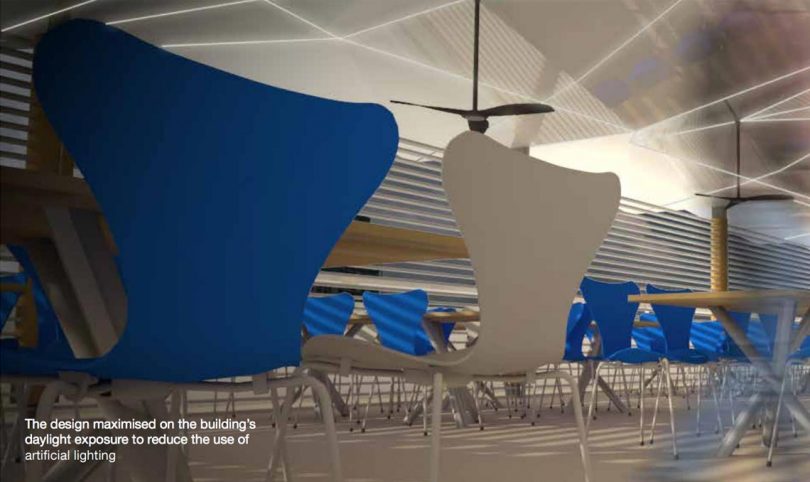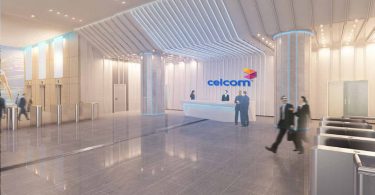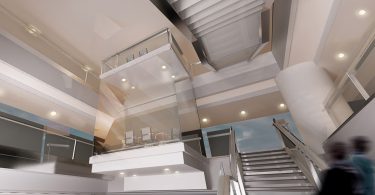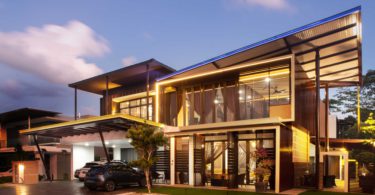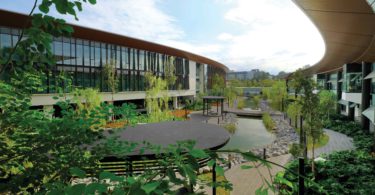The design team at Hijjas Kasturi Associates Sdn approached the brief pragmatically to incorporate 97,000 square metres of gross floor area within a site area of 4595.16 square metres. The design was conceived in 2009 after meticulous research was carried out on-site and direct consultations. At an average height of 148 metres, the Celcom Headquarters is part of the extensive master plan for the PJ Sentral Garden City Project and will be one of the first to be erected within the proposed development. The 33-storey office tower commenced construction in early April 2013. The building is located in the heart of Petaling Jaya, Malaysia with key accessible points via public and private transportation.
The building typologies surrounding the immediate context for the Celcom Tower consist mostly of government and privately run commerce and leisure industries, with a 50-percent allocation of the built-up area designated as office buildings, 25 percent allocated to the hospitality industry and the remaining 25 percent for serviced apartments. A 500-kilometre radial offset of the development consists mostly of residential property.
In order to achieve LEED and Gold GBI Certification, the team relied on the exchange of expertise from local and foreign consultants appointed by the client to work with existing available qualities that the site could offer. Overall, the building used 30 percent of recycled content materials and 30 percent of regional materials that were sourced no more than 500 kilometres away from the site. On average, 60 percent of the materials used for the construction of the substructure, superstructure and internal finishes were sourced locally. The remaining 40 percent of external finishes, such as glass and aluminium cladding, were outsourced. A percentage of the material selection used for the project comprised low-volatile organic compound (VOC) products. System formwork casting was also used as a construction method for at least 23 levels of the typical tower levels to limit material wastage and reuse the concrete moulds. Since the building is sited on a north-east and south-west axis, the design maximised on its daylight exposure to reduce the use of artificial lighting within the office areas of the building.
However, this exposes the building interior to extreme heat gain. In order to moderate the impact, low-E glass with appropriate VLT and low shading coefficient (SC) (<0.25) will be used throughout the building along with the proposed incorporation of fritted glass. However, faced with budgetary constraints, this issue had to be addressed via value engineering efforts which resulted in the reduction of certain specifications and qualities concerning the glass thickness, as well as U, SC and building energy intensity (BEI) values.
The design utilises the roof curvature and surface area of the façade to harvest 4 percent of the collected rainwater for irrigation of the external landscape areas. The building also aims to use high-efficiency water fittings to achieve 50 percent reduction in potable water usage. Seventy-five percent of the roof surface material will be higher than SRI-29 (low-slope requirement) or vegetated. projects Canopy A is situated at the entrance drop-off area on the ground level and can collect 5,655 square metres of surface runoff from the south-east elevation. Canopy B can potentially collect runoff from the south-west (4,113 square metres), north-west (7,838 square metres) and north-east (4,113 square metres) elevation at Podium 6 and retain the cumulative volume at Podium 5, before distributing 4 percent of grey water for landscape irrigation. The water catchment area also includes the roof level and additional 2,000 square metres on Podium 6. The total water collected is approximately 16,000 litres per year.
The location of the site is well connected in terms of accessibility. Therefore, the only long-term strategic decision to capitalise on its location and reduce the carbon footprint of the tenants is to advocate for end users to use public transport and allocate 11 percent of the total car park allocation for bicycles (52 bays), low-emission vehicles (25 bays) and carpooling (38 bays).
Location: Lot 8 (PT 11) Persiaran Barat, Seksyen 52 Mukim Petaling Jaya, Daerah Petaling Jaya, Selangor Darul Ehsan, Malaysia
Status: Under construction
Expected Completion: 31 May 2016
Site Area: 4,595.16 square metres (land size)
Gross Floor Area: 97,000 square metres
Number of Rooms: Shell and core
Building Height: 148 metres
Client/Owner: Puncak Wangi Sdn Bhd (Malaysian Resources Corporation Bhd)
Architecture Firm: Hijjas Kasturi Associates Sdn
Principal Architect: John Quek
Landscape Architect: AECOM
Interior Designer: PDI
Green Building Consultant/Engineer: Blue Snow Consulting and Engineering Sdn Bhd
Mechanical & Electrical Engineer: Perunding Eagles Sdn Bhd
Civil & Structural Engineer: Jurutera Perunding Meinhardt Sdn Bhd
Quantity Surveyor: ARH
Main Contractor: MRCB Builders

 Hong Kong
Hong Kong Singapore
Singapore Indonesia
Indonesia Tiếng Việt
Tiếng Việt ประเทศไทย
ประเทศไทย


